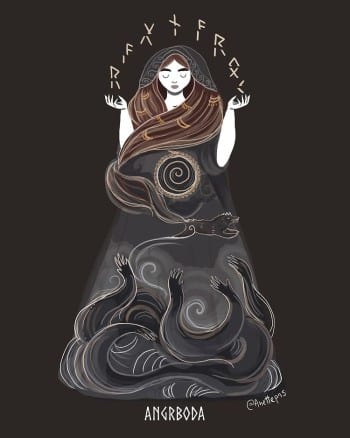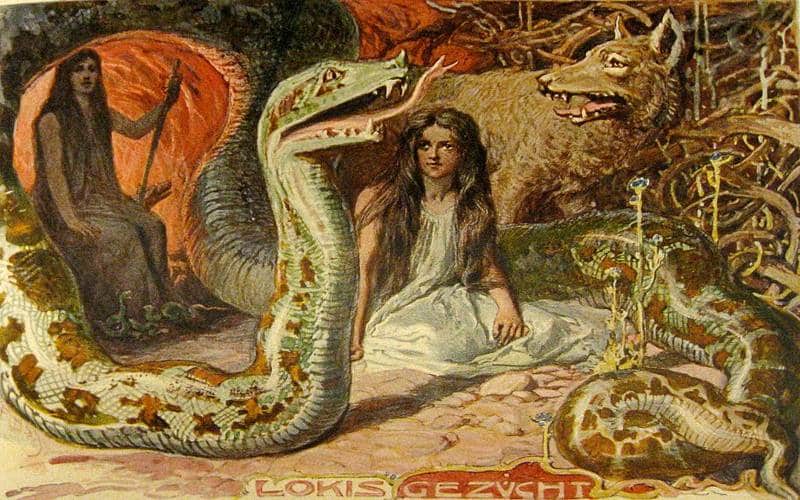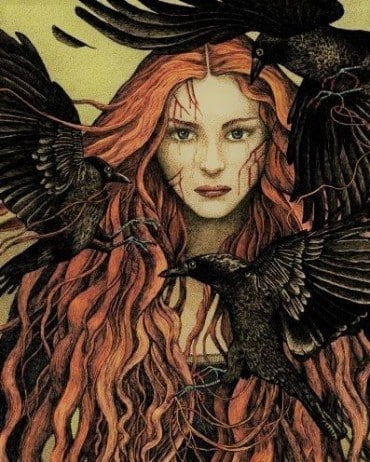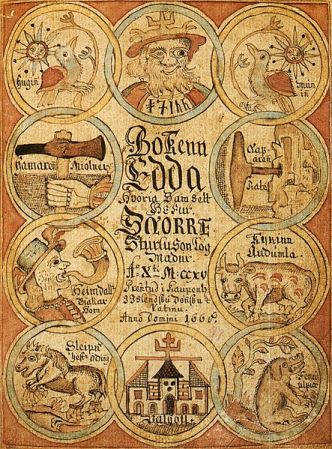In the vast tapestry of Norse mythology, Angrboda stands as a figure shrouded in mystery and intrigue. Often overshadowed by her more famous offspring and partner, this jötun giantess has a story that is both compelling and essential to the larger narrative of the Norse pantheon.
Angrboda Key Facts
| Parents | Unknown |
| Partners | Loki |
| Siblings | Not specified |
| Offspring | Fenrir, Jörmungandr, Hel, other wolves. |
| Tribe | Jötun |
| Old Norse name | Angrboða |
| Other names | None |
| Ass. Animal | Wolves |
Name and Etymology
Angrboda’s name in Old Norse, “Angrboða,” has sparked much debate among scholars and enthusiasts of Norse mythology. Some interpret it as “the one who brings grief” or “she-who-offers-sorrow,” drawing from the word “Angr,” which can be translated to “anger” or “grief.” Another interpretation, albeit a bit simplistic, is “harm-bidder.”
However, a deeper dive into the linguistic nuances reveals a more layered understanding. Across most of Scandinavia, the word “anger” translates to “regret.” Given this, her name could also be seen as “she who brings regret” or “bearer of remorse.” This interpretation aligns with her role in the myths, especially considering the tragic fates of her offspring and the impending doom of Ragnarok.
Kennings, poetic metaphors used in Norse literature, often allude to her as the “mother of monsters” or “Loki’s consort,” further emphasizing her significance in the grand narrative of Norse mythology.
Ancient roots
While Angrboda’s name is deeply rooted in Norse mythology, it’s challenging to trace its origins to older mythologies like Germanic or Gothic traditions. However, the concept of a giantess or a powerful female figure associated with chaos and destruction is not uncommon in ancient European myths.
Angrboda’s Origins

Angrboda’s lineage remains a mystery, as the ancient texts do not provide explicit details about her parents or siblings. What we do know is that she hailed from Jotunheim, the realm of the giants, and was a prominent figure among the jötnar (giants).
Her association with Loki, the trickster god, is perhaps the most defining aspect of her story. Their union, often described as tumultuous and passionate, resulted in the birth of three of the most formidable beings in Norse mythology.
Angrboda’s Family and Relationships
Angrboda’s relationship with Loki is central to her narrative. Their union, though not based on marital bonds, was significant enough to produce three beings that would play pivotal roles in the events leading up to Ragnarok.
Offspring

Fenrir, the monstrous wolf, was their firstborn. Foretold to wreak havoc during Ragnarok, the gods bound him, leading to a series of events that further strained the relationship between the Aesir and the jötnar.
Jörmungandr, the Midgard Serpent, was another of their offspring. This massive sea serpent encircled the world and was fated to battle Thor during the end times.
Lastly, Hel, the ruler of the underworld realm bearing her name, was given dominion over those who did not die a heroic or notable death.
Angrboda in Járnvid: Breeding Fenrir’s Kin?
The Völuspá, or the “Prophecy of the Völva,” introduces a jötunn residing in Járnvid (Ironwood), a forest known to be the dwelling of female jötnar. This giantess, widely believed to be Angrboda, is described as raising Fenrir’s kin.
To the east sat the old lady in Járnvid And raised there the kinfolk of Fenrir.
Snorri Sturluson further elaborates on this in Gylfaginning:
Then spoke Gangleri: ‘What is the origin of the wolves?’
High said: ‘A certain giantess lives east of Midgard in a forest called Ironwood. In that forest live trollwives called Iarnvidiur. The ancient giantess breeds as sons many giants and all in wolf shapes, and it is from them that these wolves are descended…
Angrboda – Mother and Consort of Fenrir?
The implication here is that Angrboda, after giving birth to Fenrir, might have had further offspring with him, resulting in a brood of wolves. In the context of Norse mythology, such relationships, while complex and challenging to our modern sensibilities, are not entirely out of place. The gods and giants of these myths often have intricate and intertwined relationships that don’t always align with contemporary moral standards.
This potential relationship between Angrboda and Fenrir, if true, underscores the intricate web of relationships in Norse mythology and the blurred lines between creation, destruction, and rebirth. It adds depth to Angrboda’s character, painting her not just as a mother of monsters but also as a central figure in a complex narrative of fate, destiny, and cosmic cycles.
Play Jötunn Quiz
Do you want to learn more about the magical and powerful Jötunn? Then test your knowledge with this fun quiz game!
Don’t forget to play our other games as well!
Angrboda’s Roles And Responsibilities
While Angrboda was not a goddess with specific domains or responsibilities like Frigg or Freyja, her role was crucial in the grand scheme of things. As the mother of three beings central to the prophecy of Ragnarok, her existence was intertwined with the fate of the gods and the world.
Her presence in Jotunheim and her relationship with Loki made her a bridge between the worlds of the gods and the giants. In many ways, she embodied the tension and eventual conflict that would arise between these two realms.
Mother to Sköll and Hati?
If we further explore the implications of Angrboda being the jötun giantess residing in Ironwood, another layer of her narrative unfolds. This association suggests that she might also be the mother to Sköll and Hati, two infamous wolves in Norse mythology.
Sköll and Hati are not just any wolves; they have a cosmic significance. Hati is foretold to chase and eventually devour Sol, the sun, while Sköll pursues and consumes Máni, the moon. Their actions are instrumental in setting the stage for Ragnarok, as their successful hunt of these celestial bodies will plunge the world into darkness, signaling the beginning of the end.
If Angrboda is indeed their mother, her role as a harbinger of destruction becomes even more pronounced. Not only are her children responsible for the deaths of major gods like Odin, Thor, and Tyr, but they also bring about the cosmic disruptions that precede Ragnarok. Through Fenrir, Jörmungandr, Hel, Sköll, and Hati, Angrboda’s legacy is one of chaos, change, and the cyclical nature of existence, where endings pave the way for new beginnings.
Depiction And Characteristics

Angrboda’s portrayal in the myths is that of a powerful and enigmatic figure. While not much is detailed about her personality, her role as the mother of monsters speaks volumes about her significance.
Her relationship with Loki, a god known for both his cunning and deceit, suggests a complex character. The fact that she bore children who would challenge the gods hints at a rebellious and defiant nature.
Angrboda and Echidna: Mothers of Monsters Across Mythologies
When delving into the world of myths and legends, it’s fascinating to uncover parallels between different cultures. One such parallel exists between Angrboda of Norse mythology and Echidna from Greek tales. Both are renowned as “mothers of monsters,” giving birth to some of the most fearsome creatures in their respective mythologies.
Origins and Lineage
The jötun Angrboda, is central to the Norse narrative due to her offspring with Loki: Fenrir, Jörmungandr, and Hel. Each of them play a pivotal role in the events during Ragnarok, the end of the world.
Echidna, on the other hand, is often described in Greek mythology as a nymph with the body of a serpent and the upper half of a beautiful woman. She is the mate of Typhon, another monstrous entity. Together they birthed a series of creatures that would challenge gods and heroes alike.
Offspring and Legacy
Both Angrboda and Echidna’s legacies are deeply intertwined with their children. Angrboda’s offspring are central to the Norse end times: Fenrir is destined to slay Odin, Jörmungandr will engage in a fatal battle with Thor, and Hel oversees the realm of the dead.
Echidna’s progeny, meanwhile, are a who’s who of Greek mythological monsters. Among her children are the Nemean Lion, which Hercules had to defeat as one of his Twelve Labors; the Chimera, a fire-breathing hybrid creature; the Sphinx, known for her riddles; and finally the multi-headed serpent, Hydra.
Symbolism and Significance
Both Angrboda and Echidna serve as symbols of chaos and destruction in their respective mythologies. Their offspring challenge the established order, whether it’s the gods of Asgard or the heroes of ancient Greece. Yet, their roles are not just about destruction; they also represent the cyclical nature of life, death, and rebirth. The challenges their children pose lead to new beginnings and the continuation of cosmic narratives.
Mentions in Ancient Texts

Throughout the annals of Norse mythology, various ancient texts provide glimpses into the enigmatic figure of Angrboða. Both the Prose Edda and the Poetic Edda, , offer insights into her identity, lineage, and significance.
Prose Edda
Gylfaginning (Beguiling of Gylfi)
Gylfaginning provides a detailed account of Angrboða’s offspring with Loki: Fenrir, Jörmungand, and Hel. The gods’ apprehension towards these children, stemming from both their mother’s and father’s nature, is evident.
“There was a giantess called Angrboda in Giantland [Jötunheimr]. With her Loki had three children. One was Fenrir, the second Iormungand [the Midgard serpent], the third is Hel. And when the gods realized that these three siblings were being brought up in Giantland, and when the gods traced prophecies stating that from these siblings great mischief and disaster would arise for them, then they all felt evil was to be expected from them, to begin with because of their mother’s nature, but still worse because of their father’s.”
— Gylfaginning, 27–34, trans. A. Faulkes, 1987.
Giantess in Ironwood
Snorri Sturluson in Gylfaginning also paraphrases a stanza from Völuspá, hinting at Angrboða’s potential identity as the jötunn in Ironwood, breeding wolves.
“Then spoke Gangleri: ‘What is the origin of the wolves?’
High said: ‘A certain giantess lives east of Midgard in a forest called Ironwood. In that forest live trollwives called Iarnvidiur. The ancient giantess breeds as sons many giants and all in wolf shapes, and it is from them that these wolves are descended…'”
— Gylfaginning, 12–14, trans. A. Faulkes, 1987.
Poetic Edda
Völuspá hin skamma (Short Völuspá)
This poem directly mentions Angrboða as Loki’s mate and the mother of Fenrir.
“Loki sired the wolf on Angrboda, and got Sleipnir on Svadilfari; the witch alone seemed most evil the one that came from the brother of Byleipt.”
— Völuspá hin skamma, 40, trans. J. Lindow, 2002.
Völuspá (Prophecy of the Völva)
The Völuspá provides a hint towards Angrboða’s identity as the jötunn in Járnvid, raising Fenrir’s kin.
“To the east sat the old lady in Járnvid And raised there the kinfolk of Fenrir.”
— Völuspá, 40, trans. J. Lindow, 2002.
Eggþér’s Role
In stanza 42 of Völuspá, Eggþér is portrayed as the herder of the jötunn in Járnviðr (Ironwood). Some scholars, like Peter H. Salus and Paul B. Taylor, speculate that he might have been Angrboða’s wolf-herder, further connecting her to the Ironwood narrative.
Frequently Asked Questions
Angrboda is best known as the mother of three monsters. Fenrir, Jörmungand, and finally Hel—who all play crucial roles in the prophecy of Ragnarok.
No, she was a jötun giantess from Jotunheim.
While they had a significant relationship, they were not bound by marital ties.
She is depicted as a powerful and enigmatic figure, primarily known for her offspring who challenge the gods.
She hailed from Jotunheim, the realm of the giants.
Featured Image Credit: Emil Doepler, Public domain, via Wikimedia Commons
